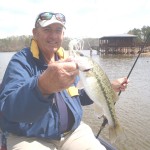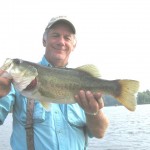by: Jeff Moss
Alabama DNR
Walleye are cool water fish not often associated with the southern waters, but Alabama’s large rivers all contain walleye. In fact, Alabama is home to two subspecies of walleye and several locations have fishable populations of walleye. That is good news because walleye are one of the tastiest fish found in Alabama.
The walleye is the largest member of the perch family, which includes darters, yellow perch, sauger and log perch. Walleye are usually found in large river systems and associated tributaries and streams. They generally prefer secluded backwaters having an abundance of deep, clear water. In Alabama, walleye live an average of seven years and may reach up to 31 inches in length. The current state record (10 pounds 14 ounces) was caught in 1980 in Weiss Reservoir, an impoundment of the Coosa River.
The northern strain of walleye is found in the Tennessee River and the southern strain is found in the Mobile basin and its tributaries. The northern strain has been stocked in waters with the southern strain, but recent genetic studies conducted by Auburn University indicate that these stockings were generally unsuccessful. The best locations to catch walleye include Hatchet and Weogufka Creeks on Lake Mitchell, North River in Tuscaloosa County, the Cahaba River, Oakmulgee Creek in Perry County and the Tallapoosa River near Thurlow Dam. The best time to catch walleye is when they move upstream to spawn.
Anglers have the best chance of catching walleye in January, February and March, fishing live minnows or jigs adjacent to deep drop-offs or holes during spawning runs. The best time to catch walleye is usually during the worst possible winter weather conditions. Walleye typically move into shallow, fast-water shoal areas to spawn when water temperatures approach 45 û 52 degrees F. Spawning runs may begin in December and continue through early April, depending upon water temperature and water conditions. Male walleye are thought to begin their spawning runs prior to the arrival of the larger females. Females disperse their eggs over gravel or sand bottoms but prefer rocky substrate if available and generally spawn in water 12 û 30 inches deep. Concentrations of fish tend to be higher below dams that prevent migration upstream.
During the summer, the most popular method to catch walleye in large lakes is by trolling in deep open water areas, often at night. Walleye have large eyes, which are sensitive to light, and they prefer dark cool-water havens having maximum summer temperatures no greater than 77 degrees F. Walleye can often be found in springs or streams in large reservoirs that serve as thermal refuge areas, which are also attractive to several coolwater species.
Walleye are rated as excellent table fare whether fried or baked. Among the freshwater fishes, none are considered a better eating fish than the walleye and their close relative, the sauger. Both offer firm white flesh with a sweet flavored meat that is preferred among most anglers. In northern and mid-western states, walleye are considered a delicacy at local restaurants where they are legal to serve commercially.
Anglers in Alabama need to be aware of walleye because they are often mistaken for trash fish. Rare encounters with walleye should be noted by throwing the fish in the cooler and enjoying its delicate flavor while telling tales about the big one that got away.
Note – I have caught a few walleye on my trips to Wisconsin each year but have caught only two in Georgia, both at Lake Russell. At one time a few lakes in Georgia were stocked with walleye but they are not successful except in a few of our norther lakes. Carters Lake is one good lake in Georgia where you can catch walleye.






